The AMD Llano Notebook Review: Competing in the Mobile Market
by Jarred Walton & Anand Lal Shimpi on June 14, 2011 12:01 AM ESTApplication Performance, Round One: PCMark 7
If the battery life was a pleasant change of pace, general application unfortunately remains a weak spot for AMD. Remember that Llano uses a tweaked K10.5 architecture for the CPU portion of the core, and while L2 cache per core is doubled relative to the previous generation quad-core Phenom parts, clock speeds and IPC (instructions per clock) still appear much lower than what Intel offers. I had hoped to see Turbo Core come into play here, which makes the comparison with Toshiba’s A660D a good starting point. That notebook has a Phenom II X4 P920 (quad-core 1.6GHz) with HD 5650M graphics, so the Llano A8-3500M has very similar specs.
Before we get to the graphs, let me make a quick note that not all laptops have been tested in all applications/games. Most of the systems have been shipped back to the manufacturer, so our newer benchmarks are going to have omissions (e.g. PCMark 7). In the gaming charts later in the review, we’ll have even more omissions, and many of the slower GPUs/IGPs will only be tested at our “low” settings.
With that out of the way, let’s start our application performance comparison with PCMark7, our only all-inclusive benchmark for laptops right now. We’ve run all of the benchmarks suites in the hopes of providing a better look at overall performance; however, outside of the “Computation” suite all of the tests have a storage element. That means any system with an SSD (like the quad-core SNB unit) will boast a massive advantage over the competition. The Computation suite also has an interesting footnote in that it supports Intel’s Quick Sync for video encoding, which again gives SNB systems a massive performance advantage. You can read more about the specific suites in PCMark 7 in their whitepaper. We’ll also have two results for Llano going forward: one for using the fGPU (6620G) and a second for using the dGPU (6630M).
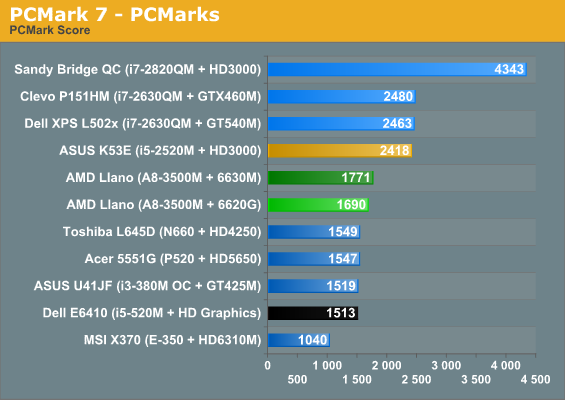
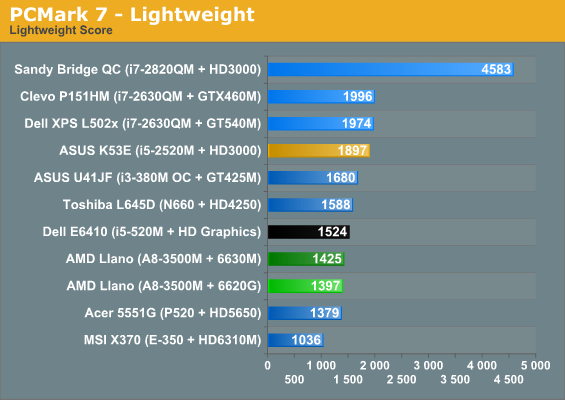
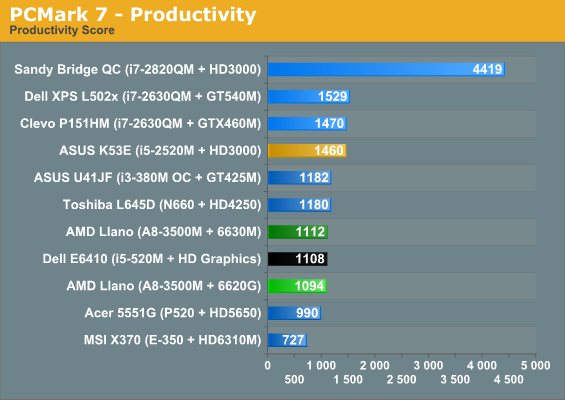
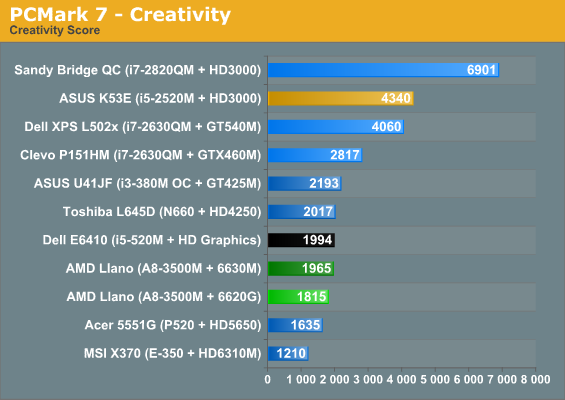
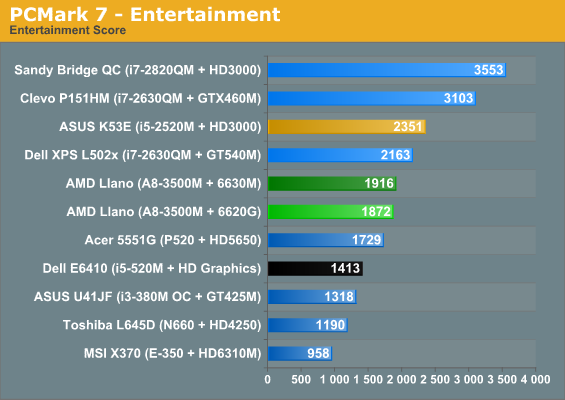

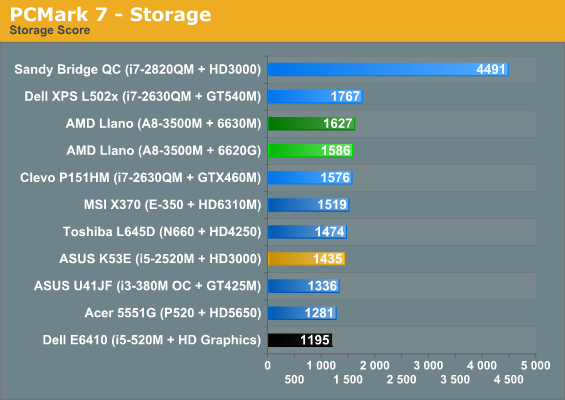
And here’s our first hint that Llano may not be the homerun so many were hoping to see from AMD. All of the SNB laptops are still a healthy step up from Llano in overall PCMarks—the K53E leads by 43%, and systems with quad-core SNB are faster still. Llano might appear to at least surpass the previous generation Arrandale i5-520M in Dell’s E6410, but the storage subsystem in that laptop is a particularly slow 160GB HDD and that skews the results. Then again, the overclocked Arrandale i3-380M in the ASUS U41JF falls short of Llano, so AMD is at the very least competitive with Arrandale.
Since we’re not on a level playing field as far as storage, we won’t comment too much more here, but I do have SSD-based testing complete for four of the notebooks, and once I’ve swapped in an SSD for Llano we’ll have a follow-up article. Let’s move on to application testing round two, where we’ll look at some tests where we eliminate the storage bottleneck.










177 Comments
View All Comments
whoaaaaaaaa - Tuesday, June 14, 2011 - link
A lot. I think you are very out of touch. No one buys desktops anymore, everyone uses a laptop - and quite a few people want to WOW or COD on them.luniq - Tuesday, June 14, 2011 - link
Agreed. A lot of people I know uses laptop although they rarely need to take it with them and they game too.swaaye - Tuesday, June 14, 2011 - link
I don't think he is. Most computer users don't play games. All they need is a GPU that can run the OS's UI.cotak - Tuesday, June 14, 2011 - link
The sort of people who use laptops and are pushing the CPUs hard are in the reality of the real world a limited bunch. Those who really need the power aren't going to be on a laptop anyhow like you say. Most office staff never use to the full potential of their issued computers even when they were using pentium 4s. And I actually think you'll find a lot of office workers are still humping around a P4 in their laptop bag.This is especially true as a lot of work now a days are done server side. About the only "office workers" who pound their CPU are those with big spread sheets. Even there I do not think you'll find many office workers who'd have an issue with most modern CPUs. They'll just go for a smoke or coffee break while it crunches.
And what review did you read that say there's no advantage in battery life? If you are pushing a game Llano lasts twice as long on the same battery.
voidi - Tuesday, June 14, 2011 - link
Lots of potential, they managed to find a valid niche in Intel's Netbook Hardware Portfolio. I think it's futile to argue about the success of this solution already, as the price will be the determining factor.As I see it, Llano has the potential to bring AMD back in the mobile market on a reasonable scale, but it also has the potential to utterly fail. Since it can't compete in the high-end area in either CPU or GPU performance, it will all depend on the value for your money. If the price is low enough, Llano will fill its niche quite comfortably.
Personally, I will wait for Trinity and Ivy Bridge, as both promise significant improvements and will likely be priced close to their predecessors.
jaydee - Tuesday, June 14, 2011 - link
On the one hand, I'm pleasantly surprised that AMD was able to bring the power draw of a K10/10.5 down to those levels, while adding decent GPU. It's a big step up for the to be in the discussion again for laptops. I don't think anyone could have reasonably expected them to go from Danube up to Intel's SB performance level overnight, so from that perspective, it's a big jump for them.On the other hand, it couldn't be more obvious that this product should have been competing against Arrendale about 18 months ago at the price point introduced today. I want to like this product badly, but it's so hard given it's CPU performance. Sure it's great for mid-range mobile gamers, but why would anyone else look at llano? Hopefully AMD can make just as big of a stride with BD-based mobile Fusion within the next 24 months, and then we can perhaps take AMD seriously in the bigger mobile market segments.
Gunbuster - Tuesday, June 14, 2011 - link
Will this mean the lowest common denominator HP $450 laptop of the week the everyone on a budget inevitably buys at retail when they are in a time crunch will suck less?I sure hope so.
Boissez - Tuesday, June 14, 2011 - link
I actually like the performance as it seems better balanced than in the dual-core Sandy bridges, ie., about 50% performancethe in single threads apps, 80% in multi-threaded apps and 200% in gaming. IOW better suited towards consumer needs. And battery life is good too.What AMD needs to work on though is lowering the TDP. A8-3500 performance in a 25W enveloppe would allow this to be a good alternative in the upcoming ultrabooks (especially because you can't fit a discrete GPU in those)
Boissez - Tuesday, June 14, 2011 - link
Oh yeah and make all of those APU's compatible with 1600 and 1866 Mhz RAM. RAM speed seems to be a major bottleneck in this platform.ET - Wednesday, June 15, 2011 - link
I think that even lower performance in 25W would be attractive, but it might eat into the E-350 market, unless it's priced significantly higher. I don't think it'd be a big problem for AMD to lower power to that point (certainly for A4), but they're probably waiting to see where the market goes with the current Llano APU's. I believe we'll see a 25W version later this year.